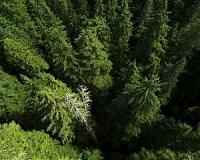| . |  |
. |
Ajdir , Morocco (AFP) April 29, 2011 Revered as the "king of the forest" in Morocco, the native cedar tree is under increasing threat from illegal logging -- a crime which also threatens the country's main water reserve. In the Ajdir forest, in the heart of the Middle Atlas mountain range, these imposing trees once covered every slope. Now their numbers are in rapid decline, to the bitter dismay of the local Berber-speaking population. "Each year thousands of trees - some of them several centuries old - are illegally felled as many forest wardens turn a blind eye," human rights activist, Aziz Akkaoui, told AFP. A favourite of cabinetmakers, cedar is a symbol of power and opulence in Morocco's stately homes and its natural oils have been known to act as an insect repellent. Now the conifer, which covers about 134,000 hectares (330,000 acres) of the North African country, is at risk of disappearing. Just a few metres from a forest warden's hut, by a tree-lined lake, lies the stump of a freshly-felled cedar. "This tree was felled with a saw whose noise the forest wardens could not help but hear," said Akkaoui, from the Moroccan Association for Human Rights. "There are the poachers who cut the cedar illegally; the carpenters who buy the wood; there are some corrupt Water and Forestry agents and some corrupt justice ministry officials," he said. "So you can talk about a cedar mafia, an organised mafia." Within the forest, some inhabitants admit that they themselves have cut down cedars illegally in order to survive in this poor mountainous area. A villager named Ahmed said: "We don't have much choice. There's nothing here." "But to cut down a tree you have to give bribes to the warden -- between 2,000 and 3,000 dirhams (190-280 euros/270-400 dollars). It depends." "Each time a group of locals want to go cut down a tree they give a forest warden a fee," he added. Each cedar, which take up to 30 years to reach maturity, can earn illegal loggers up to 800 euros. If lawfully traded, villagers can benefit from a sum three times that. Every year communities hold wood auctions which bring in around one million euros. Furious locals say they no longer profit from the trade, however. "Look around you, there's nothing," said Ahmed. "Here we are dirt poor. Why don't we benefit from the revenues of our village after the legal sales of the cedars?" "There's no work, no schools, no hospitals. We want jobs, facilities, projects to help us and improve our lives. Those responsible for managing the area's water and forest programmes deny the villagers' claims. "When someone is caught, he's obviously going to accuse a forest warden. But there's no proof to say that he gave a warden money," said Mohamed Chedid, from the Centre for Development and Protection of Forest Resources. Observers have warned for many years about the effect of the illegal trade in cedars, which hold water and reduce erosion in an area regarded as Morocco's main water reserve. "Uncontrolled logging leads to erosion and desertification, which threatens the ecological balance of the region," said academic Abdeslam Ouhejjou. "The Middle Atlas forests are Morocco's main water reserve and any disruption there has repercussions for the rest of the country," he warned.
Share This Article With Planet Earth
Related Links Forestry News - Global and Local News, Science and Application
 Era of canopy crane ending
Era of canopy crane endingSeattle WA (SPX) Apr 29, 2011 The 25-story construction crane used since 1995 to investigate such things as how Pacific Northwest forests absorb carbon dioxide, obtain sufficient water and resist attacks by pests and diseases is being pruned back to just the tower. The Wind River Canopy Crane, located in a 500-year-old forest near Stevenson in southwest Washington, has been operated cooperatively by the University of W ... read more |
|
| The content herein, unless otherwise known to be public domain, are Copyright 1995-2010 - SpaceDaily. AFP and UPI Wire Stories are copyright Agence France-Presse and United Press International. ESA Portal Reports are copyright European Space Agency. All NASA sourced material is public domain. Additional copyrights may apply in whole or part to other bona fide parties. Advertising does not imply endorsement,agreement or approval of any opinions, statements or information provided by SpaceDaily on any Web page published or hosted by SpaceDaily. Privacy Statement |